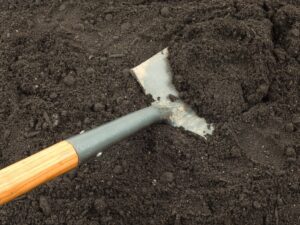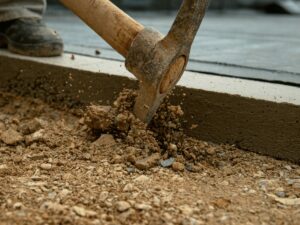Has anyone ever wondered how wells were dug before the advent of modern machinery? It’s a task steeped in tradition and manual skill.
As a drilling machine expert, I bring years of experience and insights into the age-old practice of digging wells by hand.
The art of digging water well by hand carries a special significance. It’s a method that connects us to simpler times and teaches valuable lessons about perseverance and craftsmanship.
This article will guide you through the steps, techniques, and tools needed for hand-dug wells, providing a comprehensive understanding of this traditional method.
Keep reading to learn more.
1. Understanding the Basics of Water Wells
Water wells have long been essential to human civilization, offering a means to tap into underground water sources for countless generations. A water well drilling rig is a vital tool in this process, as a water well is a structure designed to reach groundwater in subterranean aquifers. The construction of a well, including its design and depth, is influenced by a variety of factors such as the geological composition of the area, the depth of the water table, and the intended purpose of the well.
In light of the industry’s significance, it’s noteworthy to mention that, according to Business Research Insights, the water well digging industry is projected to grow with a Compound Annual Growth Rate (CAGR) of 3.0% by the year 2031. This anticipated growth underlines the continuing importance and demand for good construction and the need for adaptability and innovation in the field.
2. Site Selection for Hand-Dug Wells
Continuing from our exploration of the basics of water wells, choosing the right location for a hand-dug well is not just a matter of convenience. Here are some key considerations:
- Assessing Groundwater Availability: According to Clean Water for Laymen, the primary factor in site selection is the availability of groundwater. It’s crucial to conduct a thorough assessment of the water table’s depth and the aquifer’s yield potential. Areas with a shallow water table and abundant groundwater are ideal for hand-dug wells.
- Evaluating Soil and Geological Conditions: The soil and geological makeup of a site significantly influence the well’s stability and construction method. Softer soils are easier to dig but may require lining for stability. Conversely, rocky terrains provide natural support but are more challenging to excavate.
- Proximity to Contamination Sources: Avoiding contamination is paramount for a safe water supply. Wells should be located away from potential contaminants like septic systems, agricultural runoff, and industrial areas. A safe distance ensures the well water remains uncontaminated and potable.
- Accessibility and Practicality: The well’s location should be accessible and practical for its intended use. The site should be convenient for regular use but also situated in a way that allows for easy maintenance and servicing, a factor especially important for wholesalers and businesses involved in well maintenance.
3. Tools and Techniques in Hand Well Digging
Expanding upon the significance of selecting the right site, this next step is crucial, as the right approach can significantly influence the safety and success of the well digging process. Below are some vital considerations:
Tools for Hand-Digging
- Shovels: Essential for moving earth, shovels are the backbone of any hand-digging operation.
- Pickaxes: These are vital for breaking through harder materials.
- Buckets: Used for removing excavated soil, buckets are crucial, especially in deeper digs.
- Manual Augers: For deeper excavation, especially in challenging soil conditions, manual augers are indispensable.
- Pulley Systems and Tripods: In wells that extend to greater depths, pulley systems and tripods are essential.

Techniques for Soil Excavation
Shoveling in Soft Soil Conditions
In areas where the soil is softer, such as sandy or loamy terrains, shoveling can be a highly effective method for excavation. The use of shovels is usually sufficient for these types of soils, allowing for easy removal of earth. However, it’s crucial to frequently shore up the walls of the well to prevent potential collapses, a risk that is especially high in loose or sandy soils.

Using Pickaxes in Compact Grounds
For harder, more compact grounds, such as those containing clay or small rocks, the use of pickaxes becomes necessary. For example, a pickaxe allows for breaking through tougher soil layers, making the excavation process feasible in these more challenging conditions. This method is more labor-intensive and requires careful application to ensure both the digger’s safety and the integrity of the well.

Employing Powered Augers for Deeper Wells
In cases where the well needs to be dug to a greater depth, or the soil is particularly resistant, powered augers can be an invaluable tool. Augers allow efficient drilling into the ground, making it possible to reach deeper water tables or navigate through harder soil layers. This technique is particularly useful in reducing the physical labor required and increasing the precision of the well’s dimensions.

4. Safety Measures and Risk Management
As we transition from tools and techniques, ensuring safety is crucial for the well-being of those involved in the digging process and for the long-term stability and usability of the well. Here are some key safety aspects to consider:

Identifying Potential Hazards
Before any digging begins, identifying potential hazards is critical. This includes assessing the risk of soil collapse, understanding the regional geology to anticipate rock falls, and being aware of the presence of underground utilities or water sources that could be disrupted. A thorough risk assessment helps in preparing appropriate safety measures.
Personal Protective Equipment (PPE)
The use of Personal Protective Equipment (PPE) is non-negotiable in well digging. This includes helmets to protect against falling objects, gloves to prevent cuts and abrasions, and sturdy boots to ensure a good grip and protect against foot injuries. For deeper excavations, additional equipment like harnesses and respiratory protection may be necessary.
Emergency Preparedness
Having a well-thought-out emergency plan is vital. This plan should include immediate access to first aid, strategies for quick evacuation in case of a collapse or other emergencies, and clear communication protocols. Training all individuals involved in the well digging process on these emergency procedures is essential for effective risk management.
Regular Monitoring and Maintenance
Ongoing monitoring and maintenance of the well, especially during the digging phase, are crucial. This includes regular checks for signs of soil movement, water ingress, and structural integrity of the well. Such proactive measures can prevent accidents and ensure the safety and longevity of the well.
5. Maintenance and Upkeep
After exploring safety measures and risk management, proper maintenance is crucial for ensuring the well remains safe, functional, and provides clean water for an extended period. Here are key aspects:
- Regular Cleaning: Over time, sediment and debris can accumulate at the bottom of the well, affecting water quality. Regular cleaning and removal of these materials are essential to maintain the well’s efficiency and water purity.
- Structural Integrity Checks: Periodic checks of the well’s structural integrity, including the walls and lining, are necessary to prevent collapses or seepage. Any signs of wear or damage should be addressed promptly to ensure the well’s safety and functionality.
- Water Quality Testing: Regular testing of the water for contaminants, such as bacteria or chemicals, is vital. This ensures that the water remains safe for consumption or use.
- Preventive Measures for Contamination: Implementing preventive measures to protect the well from contamination is crucial. This includes ensuring a proper seal at the top of the well, maintaining a clean area around the wellhead, and managing nearby land use to prevent runoff contamination.

6. Challenges and Solutions in Hand-Digging Wells
As we shift our focus from maintenance and upkeep, it’s crucial to delve into the challenges that are often encountered in hand-digging wells, along with practical solutions to address these issues. Here are some significant hurdles and their effective resolutions:
Overcoming Difficult Soil Conditions
- Challenge: One of the primary obstacles to hand-digging wells is dealing with tough soil conditions. Hard, rocky, or clay-heavy soils can significantly slow down the digging process, making it labor-intensive and time-consuming.
- Solution: Addressing this challenge effectively involves the use of specialized tools designed for these specific conditions. Manufacturers like Drillrigy offer a range of equipment that are specifically designed for these challenging conditions, helping to streamline the process and improve overall efficiency.
Dealing with Water Ingress
- Challenge: Another common challenge is water seeping into the well during the digging process, especially in areas with high water tables. This can not only slow down the work but also pose safety risks due to the instability it causes.
- Solution: Addressing this issue involves several strategies. Installing submersible pumps to continuously remove water during the digging process is a primary solution. Using well casing or liners can provide temporary support to the well walls, preventing further water ingress. It’s also beneficial to plan the digging during seasons with lower water tables, if possible.
Ensuring Consistent Depth and Diameter
- Challenge: Maintaining a consistent depth and diameter is vital for the well’s structural integrity but can be difficult, particularly in soft or unstable soils.
- Solution: Regular measurements and adjustments are necessary. Using guide rings or installing temporary casing can help maintain the well’s shape during excavation. Moreover, training diggers to maintain consistent digging patterns and regularly checking progress against a predefined well design can ensure the well maintains its intended dimensions.
Managing Environmental and Seasonal Factors
- Challenge: Environmental factors such as weather conditions and seasonal changes can greatly impact the well-digging process. Heavy rains, extreme heat, or cold can halt work, while seasonal variations can affect soil conditions and water tables.
- Solution: Drillrigy recognizes that effective management of these factors involves careful planning and adaptability. Scheduling the digging during seasons with mild weather and fewer precipitation risks is ideal. Understanding and planning around the seasonal fluctuations in water tables can also aid in choosing the best time for digging.
Here’s a table summarizing Drillrigy’s approach to managing environmental and seasonal factors in drilling operations:
| Factor |
Management Strategy |
Importance |
| Seasonal Weather |
Scheduling drilling during mild weather conditions with less precipitation. |
Minimizes the impact of adverse weather on drilling operations and safety. |
| Water Table Fluctuations |
Understanding seasonal changes in water tables. |
Aids in determining the most suitable time for drilling to ensure efficiency and safety. |
| Planning and Adaptability |
Careful planning and flexibility in response to environmental conditions. |
Essential for successful drilling operations while mitigating risks and delays. |
7. 4 Factors to Consider When Digging Wells by Hand
Moving from the challenges and solutions associated with hand-digging wells, it’s important to highlight specific factors critical to the manual digging process. Here are essential factors to consider:
#1 Depth and Diameter Planning for Manual Excavation
Hand-digging naturally limits how deep and wide a well can be compared to machine drilling. Therefore, it’s crucial to plan these dimensions thoughtfully to ensure the well can access sufficient water and maintain structural stability. This careful planning helps avoid over-exertion and ensures that the well serves its intended purpose efficiently.
#2 Soil Type Assessment for Hand-Dug Wells
The soil’s composition, whether it’s sandy, loamy, clay-heavy, or rocky, significantly impacts the digging method and tools required. For instance, sandy soils might require more shoring to prevent collapse, while rocky soils might necessitate the use of heavier tools. Assessing the soil type beforehand helps in choosing the right tools and techniques, thereby ensuring a safer and more efficient digging process.
#3 Water Table and Seasonal Variations
Digging during a season when the water table is at its highest can make the process easier and ensure a reliable water source year-round. However, it also means dealing with potential water ingress during the digging process. Understanding these variations assists in planning the digging schedule and preparing for any challenges that might arise due to changes in the water table.
#4 Manual Labor Challenges
Anticipating and preparing for the physical challenges is crucial. This preparation includes ensuring a team is physically capable, understanding the time and effort required, and planning for adequate breaks and shifts to avoid exhaustion. Additionally, having a clear understanding of the physical demands helps in setting realistic timelines and expectations for the completion of the well.
Conclusion
Digging a water well by hand is not just about creating a water source; it’s about embracing a time-honored technique that has sustained communities for centuries. This method, though labor-intensive, offers a sense of accomplishment and a connection to the earth that modern machinery cannot replicate.
If you’re seeking top-quality borehole drilling machines, look no further than Drillrigy. Our equipment embodies the perfect blend of traditional understanding and modern efficiency. Contact us today to learn more.






